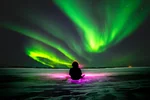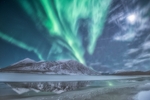Why the Solar Maximum means peak Northern Lights in 2024/2025
The Northern Lights are a natural phenomenon where bright colours ripple across the night sky in the Northern Hemisphere. Scientists at NASA predict that 2024 and 2025 will be fantastic years to view the lights.

Solar activity causes aurora when it interacts with the Earth's atmosphere. The sun is expected to reach the peak of its 11-year cycle (the solar maximum) in 2024, which means more intense and frequent Northern Lights during 2024 and 2025. If you want to go on a Northern Lights trip, you should start planning now!
Table of contents
- Popular Northern Lights Trips in 2024-2025
- What is the solar maximum?
- The science behind the solar maximum
- Why this solar maximum is special
- Northern Lights and the solar maximum
- Preparing for your Northern Lights adventure
- The solar maximum and you: safety and enjoyment
- Conclusion
- Frequently asked questions
Popular Northern Lights Trips in 2024-2025
Aurora and Astronomy in Churchill
Spend five nights at the Churchill Northern Studies Centre and learn about the Northern Lights and Canada’s subarctic region. In addition to looking for the mystical aurora, you can attend research presentations and cultural workshops, and try winter outdoor activities like dogsledding.
Trip length (number of nights): 7
Nights in Churchill: 5
Aurora viewing evenings: 5
When to go: February
Fall Colours and Northern Lights in Yellowknife
Travel to Yellowknife in the Northwest Territories to enjoy three nights of guided Northern Lights viewing. During the day, go hiking, fishing, boating, or wildlife viewing. At night, gaze up at the sky in search of the colourful aurora.
Trip length (number of nights): 4
Nights in Yellowknife: 4
Aurora viewing evenings: 3
When to go: August-October
What is the solar maximum?
Solar maximum is the period of peak solar activity during the sun’s approximately 11-year solar cycle. It occurs around the middle of each cycle when the sun has the most sunspots. In comparison to solar maximum, the solar minimum marks the beginning of the solar cycle and is when solar activity is at its lowest.
So, what is solar activity? The sun's surface has electrically charged gases that create magnetic fields. The constant movement of these gases and magnetic fields creates solar activity, which varies throughout the sun's cycle. One of the ways in which scientists can predict the sun's activity is by looking at the number of sunspots. At solar maximum, the sun will be full of sunspots, while at solar minimum, there will be very few. Sunspot observations have dramatically increased since 2022, and solar activity is expected to rise steadily until fall 2024.
Solar flares and coronal mass ejections are also common during solar maximum. Solar flares are explosions of energy that usually occur near sunspots. Coronal mass ejections are large bubbles of corona plasma that erupt from the sun's surface.
The science behind the solar maximum
Scientists have kept track of the solar cycle and solar maximums since 1755. The sun is currently in Cycle 25, which began in December 2019.
Previous solar forecasts and predictions of the solar maximum suggested that the next solar maximum would be in 2025. Due to the recent increase of sunspots, it is now thought that these predictions were wrong and that the solar maximum will happen earlier than expected.
In 2023, a number of intense solar storms were observed. At least 12 x-class flares, an enormous coronal hole, two cannibal coronal mass ejections, a solar tornado, and a polar vortex were recorded in the last year. These rare solar phenomena are more common close to solar maximum.

Keep reading or chat with one of our local travel experts. We’re passionate about Canada and can help you at any stage of your vacation planning.
Why this solar maximum is special
The upcoming solar maximum is expected to arrive sooner and last longer. It's predicted to be between January 2024 and October 2024. When thinking about the Northern Lights, this is fantastic news.
The Northern Lights (aurora borealis) appear when charged sun particles collide with the Earth's upper atmosphere. So, if there is a high amount of solar activity, there is likely to be frequent and stronger Northern Lights displays. During solar maximum, it will be peak time for viewing the Northern Lights.
The last solar cycle (Cycle 24) was a weak one and the current activity is strong, meaning you'd have to go back at least 20 years to see this level of aurora activity. In fact, Cycle 24 was the weakest one in 100 years.
Northern Lights and the solar maximum
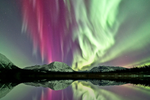
While the Northern Lights can be observed throughout the solar cycle, during the solar maximum there are higher chances of spectacular aurora displays. If you'd like to witness the Northern Lights, choosing trip dates close to the solar maximum is a great idea. The Northern Lights will remain active during the years after the solar maximum too. Peak years for seeing the Northern Lights will be 2024 and 2025.
Another advantage is that the auroral oval expands during solar maximum. This means you may see weak Northern Lights in locations further south than you would normally see them, but the best locations —such as Manitoba, Yukon, and Northwest Territories in Northern Canada — will have truly amazing displays. These remote destinations have ideal conditions for Northern Lights viewing, including low light pollution, minimal cloud cover, and clear, dark skies in the fall and winter months.
On a Canadian Northern Lights trip, you can enjoy multiple evenings of aurora viewing. These experiences happen between the hours of 11pm and 3am, so be prepared to stay up late! Local travel guides can take you to the best viewing spots and share insight into the aurora.
If you want to capture the Northern Lights on camera during solar maximum 2024, you'll need to make sure your device is set up correctly. It's possible to capture images of the Northern Lights on your phone as well as more advanced camera systems. A few tips for aurora photography include:
- Using manual camera settings
- Using a wide-angle lens with low aperture
- Using a low shutter speed
- Using a high ISO value
Preparing for your Northern Lights adventure
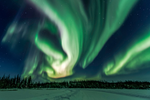
Canada is home to some of the best destinations for Northern Lights viewing. The country's northern regions fall under the auroral oval. Churchill in Manitoba, Whitehorse and Dawson City in the Yukon, and Yellowknife in the Northwest Territories are recommended places for a Northern Lights trip in Canada.
The best seasons for aurora viewing in Canada are winter and fall. You need dark, clear skies to see the Northern Lights, which is why November to April is often the recommended time for trips to Northern Lights destinations. The fall season, between August and September, is another popular time to visit the Yukon, the Northwest Territories, or the Rockies. The main differences between the two seasons are the type of daytime activities that you can do on your trip and the weather conditions and temperatures.
There are different trip and tour options, depending on when and where you'd like to travel. Accommodation varies from remote lodges to science centres to downtown hotels.
Guided Northern Lights experiences in Canada take you to the best viewing spots. These places could feature campfires, hot drinks, cozy tents, or heated cabins so that you can keep warm while waiting for the aurora.
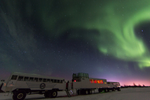
Some Canadian locations offer unique experiences. You could:
- Take a tundra buggy across the frozen tundra to view the aurora in Churchill (February)
- Stay at Gangler's Lodge for a remote safari experience near the provincial border between Manitoba and Nunavut (August or September)
- Learn the science of the Northern Lights and about the subarctic region at the Churchill Northern Studies Centre (February)
- Sleep in beautiful glass chalets, made specifically for optimal viewing, at Northern Lights Resort and Spa (August-October, or November-March)
- Discover the history of the Gold Rush in the Yukon
- Travel along the famous ice road or enjoy fishing on Great Slave Lake in Yellowknife
- Try activities such as dogsledding, snowmobiling, ice fishing, and snowshoeing on a winter Northern Lights trip
- In the fall season, go hiking, fishing, or wildlife viewing on a trip to the Yukon or the Northwest Territories
If you are interested in seeing the aurora in Canada during 2024, please contact one of the travel experts at Northern Lights Canada and we can find the best itinerary for you. Northern Lights 2025 trips are also available.
The solar maximum and you: safety and enjoyment
During periods of increased solar activity, there can be frequent solar flares and geomagnetic storms. Some scientists say that if a solar storm hits Earth, it could affect radio, satellite, and internet signals. This would depend on the strength of the storm.
As mass coronal injections fall into Earth's atmosphere, these surges can disrupt several manmade and natural systems. Potential effects could be radio blackouts, animal migration disruptions, satellite orbit disruptions, metallic infrastructure damage.
When thinking about a Northern Lights trip during the solar maximum, there are no major safety concerns. To set expectations for what your Northern Lights experience will be like, you can monitor weather conditions and aurora forecasts before you leave home.
Conclusion
The solar maximum is a period in the solar cycle when the Sun's activity reaches its peak. This phase occurs approximately every 11 years and is characterized by increased sunspot activity, solar flares, and heightened solar radiation. One of the most captivating phenomena associated with the solar maximum is the increased likelihood of spectacular auroras, especially in polar regions. The upcoming solar maximum means that 2024 and 2025 are the best years to see the Northern Lights in Canada!
Why book your trip with Fresh Tracks Canada?
Unforgettable Canadian vacations made just for you
Enjoy local expertise and guidance with a fully planned itinerary. Personalize your trip by adding extra time in Canada at the start or end of your Northern Lights tour.
We take care of all the details
Relax and focus on making memories. Let us make all of the bookings for you, including your guided Northern Lights tour, hotels, excursions and activities, and transfers.
Support when you need it
We’re here to make sure you get the inside scoop before you even leave home. And you can relax on your vacation because you know that we’re a phone call away if you have any questions while you’re in Canada.
Frequently asked questions
When is solar maximum?
The next solar maximum is expected to be between January and October 2024. Solar activity remains high in the years surrounding the solar maximum.
When was the last solar maximum?
The last solar maximum was in April 2014. It was the one of the weakest solar maximums in 100 years.
When is the best time to see the Northern Lights during the solar maximum?
In 2024, the best time to view the Northern Lights is between January and March and between November and December. The winter months, with long hours of darkness, have ideal conditions for aurora viewing. August to October (the fall season) is an enjoyable time to see the Northern Lights in certain locations, like the Yukon and the Northwest Territories.
Why is 2024 the best year to see the Northern Lights?
Because of the solar maximum, Northern Lights sightings will be more frequent and more intense in 2024.
How should visitors prepare for nighttime viewing in Canadian climates?
Visitors should be prepared to stay up late for Northern Lights viewing as sightings are most common between 11pm and 3am. The Northern regions of Canada are very cold during the winter, and there can be lots of snow. You should wrap up warm and wear layers. If you do not own appropriate winter gear, you can rent items in Canada.
How does weather affect Northern Lights visibility during the solar maximum?
You need dark, clear skies and minimal light pollution to see the Northern Lights. If there are high precipitation levels or increased cloud cover, it may be challenging to view the aurora. Aurora sightings are never guaranteed, even during the solar maximum.
Are there any apps or resources for predicting the visibility of the Northern Lights?
In Canada, apps like My Aurora Forecast and websites such as the Canadian Space Agency provide real-time predictions and alerts for Northern Lights visibility.
Are there any cultural or historical aspects of the Northern Lights that visitors should know about?
The Northern Lights, known as the Aurora Borealis, are culturally significant for Indigenous peoples in Canada, including the Inuit, Cree, and Dene, who have traditional stories and interpretations associated with the phenomenon.
Do local communities or Indigenous groups offer educational programs or expereinces related to the Northern Lights?
On a trip to Canada, you could participate in educational programs related to the Northern Lights, like at the Churchill Northern Studies Centre in Manitoba. There are also cultural experiences available during the daytime on Northern Lights trips, like traditional dog sledding tours and visits to heritage museums. Many tour operators in the Yukon, Manitoba, and the Northwest Territories are either Indigenous or locally owned.
What sustainable practices are recommended for visitors to minimize their environmental impact?
Reducing energy consumption and supporting local businesses that prioritize sustainability contribute to minimizing the overall footprint. Additionally, adhering to Leave No Trace principles, such as staying on designated trails and properly disposing of waste, helps preserve the delicate subarctic ecosystems associated with Northern Lights viewing areas.
Explore Northern Lights by region
Discuss your Northern Lights tour with a Canadian travel expert


Sign up for travel inspiration
Our newsletter is full of travel tips and local insights for your Northern Lights tour in Canada.

